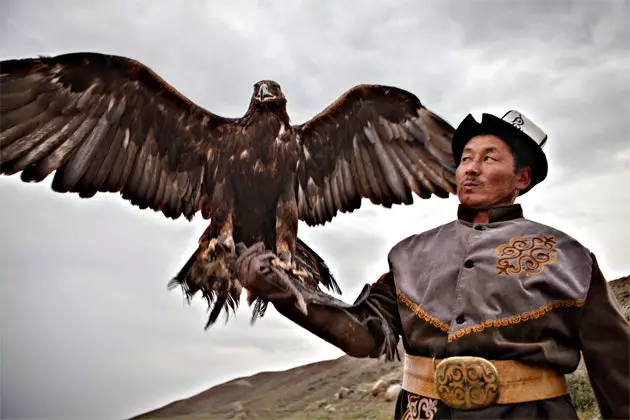
Kyrgyzstan, the Switzerland of Central Asia
The first thing that caught my attention was that when leaving the airport terminal didn't smell like anything. Nothing special, I mean ; just air. When one arrives in a place as strange and remote as Kyrgyzstan, one imagines that even the aroma of the atmosphere must be different from anything known before. Fortunately, that was the only preconceived idea of Kyrgyzstan that disappointed me. The rest of the expectations that I had placed in my backpack when I was proposed to go to such a strange country, that –for the first time in my traveling life– I had to use a map to know where it was , were more than fulfilled.
Kyrgyzstan is one of the five former Soviet republics of the Central Asia, the land of the Kyrgyz. A piece of steppe crossed to the north by the imposing mountains Tian Shan, with a very low population density –27 inhabitants per square kilometer–, and of which in the West we ignore almost everything, starting with how its name is written: ¿ Kyrgyzstan? Kyrgyzstan? Kyrgyzstan? Kyrgyz?
But if the spelling of its toponym causes confusion to the Western traveler, it is even more produced by the hodgepodge of traits and cultures he observes during his first hours in Bishkek , the nation's capital and most populous city, as he completes preparations for the grand inland expedition. Kyrgyzstan, like its four 'tan' sister republics (Uzbekistan, Tajikistan, Kazakhstan and Turkmenistan), has been a historical land of passage along the Silk Road (Turks, Mughals, Uzbeks...); if we add to that more than 100 years of Russian domination (first Tsarist, then Soviet), the amalgamation is worthy of the Babel Tower.
There are times when you wander the streets of Bishkek that you think you are in the former Soviet Union; other times, turning the corner, the scenery and the landscape change and then you think you are immersed in the scenery of a mongolian movie . The Russians are the minority and although they no longer control power, they still run many businesses.
Beyond provisioning the latest travel necessities and have dinner in some good restaurant for the last time in days Bishkek is nothing special for the traveler; It is a rationalist city and grid avenues laid out by the Soviets.
This is a country that becomes beautiful with altitude; in the endless open and empty spaces of its highlands. That real Kyrgyzstan begins as soon as you take the road that goes south, towards Osh . The narrow strip of asphalt goes up the slopes of a port of 3,400 meters in which the limping trucks and vehicles of Soviet origin – contemporaries of the mummy of Lenin – they see them and want to overcome slopes of 12%. Kyrgyzstan is still a poor country , with little infrastructure, and road transfers must be taken with patience.
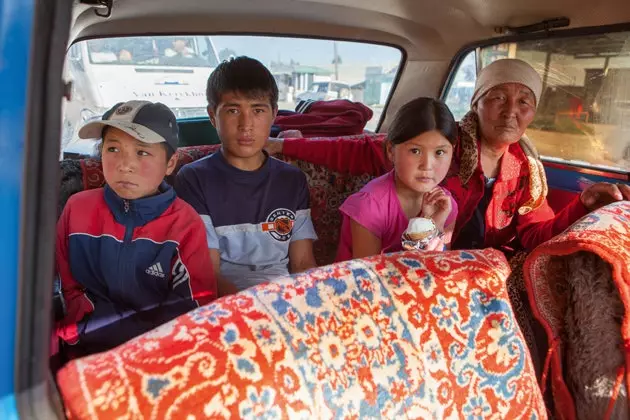
Vehicles are decorated with traditional upholstery
We stopped at some viewpoints, not so much to enjoy the scenery as to rest the engine of the old Lada. My driver takes out a kind of single-tone harmonica called os-komuz and enlivens the scene with a monochord melody, as minimalist as the herbaceous plain that opens up there below, on the other side of the port either. The oskomuz is a very typical instrument among the nomadic peoples of these steppes of Central Asia. They usually accompany him with a guitar made with horse bone that they use in festivals and tribal dances.
Once you cross the first elevation, the road enters an unfathomable plain where grass and cereals grow green and where horses and lambs graze. The horizon, more than ever, becomes infinite ; the air acquires a purity that hurts the nostrils and the blue of the sky seems painted. I am invaded by a pleasant feeling of freedom . In these open and powerful spaces far from any conventional route it seems as if worldly problems no longer exist. Here and there you can see the first yurts, the characteristic cylindrical tents of the Kyrgyz nomads. The Kyrgyz remain a farming and herding people which moves during the summer with its herds in search of pasture. The Soviets encouraged sedentarization so there are few pure nomads left. Most of the families have a house in a village and at the end of spring they go up to the high pastures with their herds of sheep, cattle and horses. In colder areas, like Sonkul, We have to wait for summer to come well because there is still a lot of snow and cold in the mountain passes.
We stopped the first night in a humble guesthouse near Chon Kemin , about 160 kilometers from Bishkek. All accommodation in the interior of the country is that basic, but you almost thank it because it is the best way to get in contact with this town of kind and short people, wearing a ridiculous felt hat that looks like a pot upside down and that they are always smiling. Near the village there are several yurts and a man who speaks broken English offers to show us his. The tent is made with a wooden frame and covered by heavy woolen cloths.
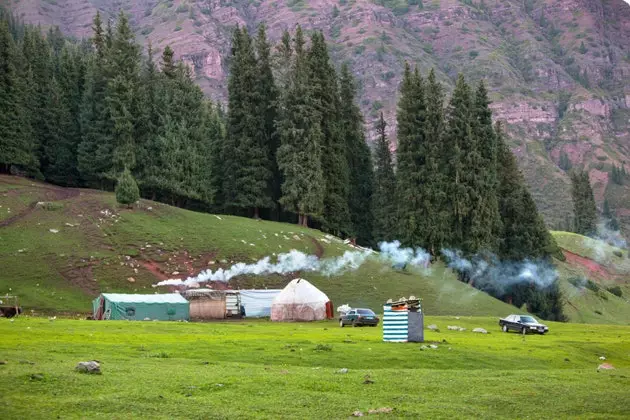
yurt base camp
He explains to me that the upper part is a wooden circle called tunduk ; that the beams are called uuk and they are also made of wood. And that the traditional tapestries that cover the ground, called kiiz , than those that hang on the walls, which are called tuch kiiz . Not many foreigners come here and the Kyrgyz love to have contact with the few travelers who let us see them in their villages. They are no longer pure nomads, but the hospitality of life on the steppes is still ingrained in their genes and it is very easy for them to welcome you into their homes, to offer you tea and chak-chak (a dessert with cookies, honey and raisins ) or simply trying to strike up a conversation with you by asking you in rough English where do you come from or what is your name . Despite having hardly any furniture, the yurt is cozy and spacious ; He tells me that ten members of the same family fit without problems.
One of the best experiences I could live in Kyrgyzstan was a horse route . The horse is Kyrgyz's best friend ; their life as nomads took place on the back of their mounts, which they drive with incredible alacrity. The typical image of Kyrgyzstan is still the stylized silhouette of horsemen breaking the horizontality of the plain , wearing their felt hats and always with a whip in hand to cheer on their horses. At any Kyrgyz gathering, be it an annual festival or a clan gathering, there is always a Ulak Tartish , one of the favorite horse games of the Asian steppes in which the riders dispute the carcass of a sheep as a ball; Nowadays, the remains of the animal are usually exchanged for a ball of red rags.
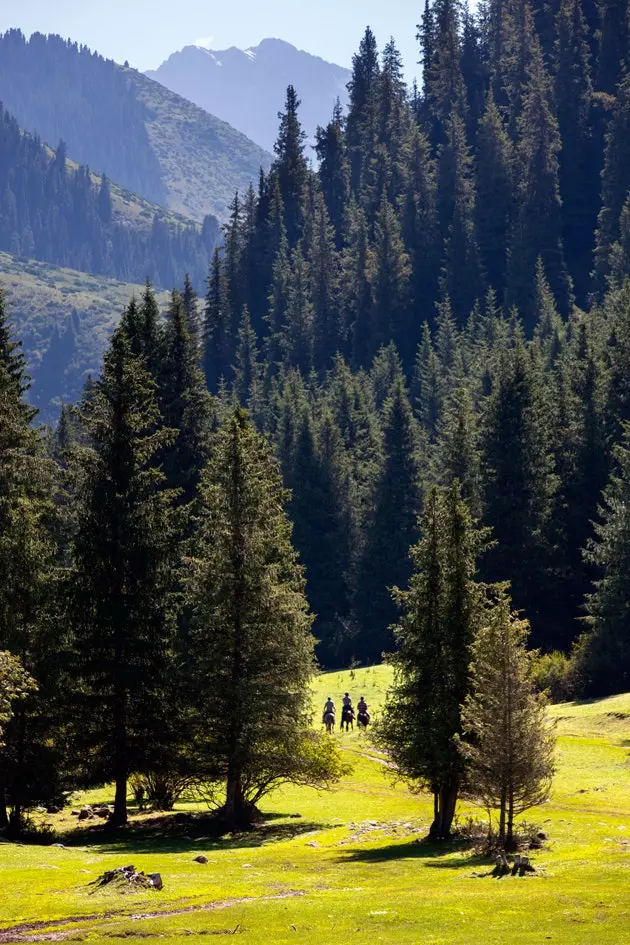
The best vehicle: the horse
We took the opportunity to make a horseback excursion through the Chon Kemin National Park , some mid-mountain landscapes with reddish soils where erosion has excavated deep gullies. We advance through lonely places where the true strength of this country is appreciated: an intact nature, hardly polluting . Industrialization has not reached Kyrgyzstan and the people of the rural world live exactly the same as when, in 1874, the tsarist troops invaded the land of the Kyrgyz, in theory with the acquiescence of the khan of Uzbekistan, who at that time dominated the north of the country.
As night falls, the guide makes us dismount, lights a fire and prepares hot drinks and lagman, a pasta with vegetable sauce and roast meat . Millions of lights tinkle in the dark vault. He blows a fresh breeze from the north and the air has been perfumed with unknown fragrances. The magic that surrounds the scene remains with us for life.
The next day we continue the journey through the solitude of the prairies in search of the lake Issyk-Kul . At the edge of the road I see precarious stalls made with four sticks where honey and curdled milk are sold. They appear lonely almost ghostly in the middle of nowhere , with half a dozen sticky bottles on the table; but if you look a little more, there's always a watchful child not far away , at the door of a yurt or sitting before a herd of sheep, ready to attend to potential customers.
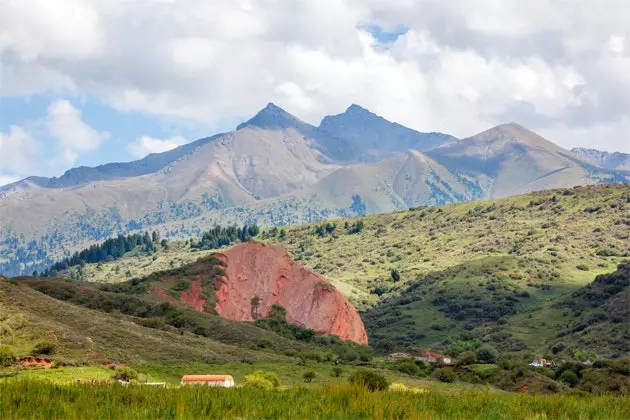
View of Jeti-Oguz, the perfect place for trekking
Far away, on the edge of the plain, snowy mountain ranges can always be seen . They look far away, as if they never got close. But towards them we advance now. In the middle are mid-mountain hills with large eroded valleys of deep red earth, just like the ones we rode through yesterday. I am surprised by the nakedness of the mountains, without a tree or a loose stone; as if they were made of clay that someone had painstakingly molded.
Kyrgyzstan is a very mountainous country , with rugged peaks and very dense coniferous forests. They call him, and rightly so, Asian Switzerland because it has bucolic landscapes that look like something out of an alpine tale.
We are now bordering the south bank of the Issyk-Kul lake , the second largest mountain lake in the world after Titicaca (Peru and Bolivia) . This gigantic inland sea It is one of the great tourist resources of Kyrgyzstan and one of the most visited areas. The little tourist infrastructure that exists in the country is concentrated around this pond of electric blue waters which, like all large mountain reservoirs, has a special light and colour. We are at 1,620 meters of altitude but the lake remains ice-free even in winter.
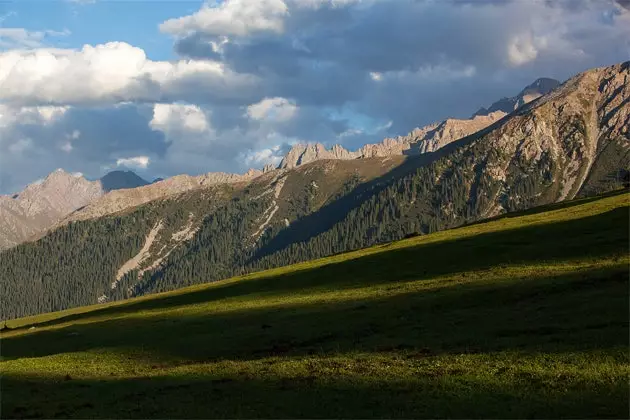
Kheti-Oguz
We stop at a spa where Russian visitors predominate. The resorts offer canoes to navigate the lake and stone beaches where you can bathe and splash around. A curious contrast if you notice that there in the background they already stand up peaks of more than 7,000 meters covered with eternal snow.
Towards that distant mountain range we are heading now. They are the Tian Shan, the 'heavenly mountains', a foothill of the Himalayas that forms the border between Kazakhstan, China and Kyrgyzstan. Its top in Jengish Chokusu , which at 7,439 meters is the highest point in the country. We set up our base camp at a yurt camp in Kheti-Oguz and from there, the next day, we trek through the bottom of an ancient glacial valley through a colossal setting of high peaks, glaciers and seracs. Once again I am immersed in the greatness of this unknown country, in its sparkling nature. You feel the telluric force of that fabulous folding , the fifth highest on the planet; imagine expeditions roped by those edges, epics of climbers capable of ascending vertical walls in which oxygen is scarce. Northeastern Kyrgyzstan is the most rugged and rugged area and, without a doubt, the most beautiful in the country.
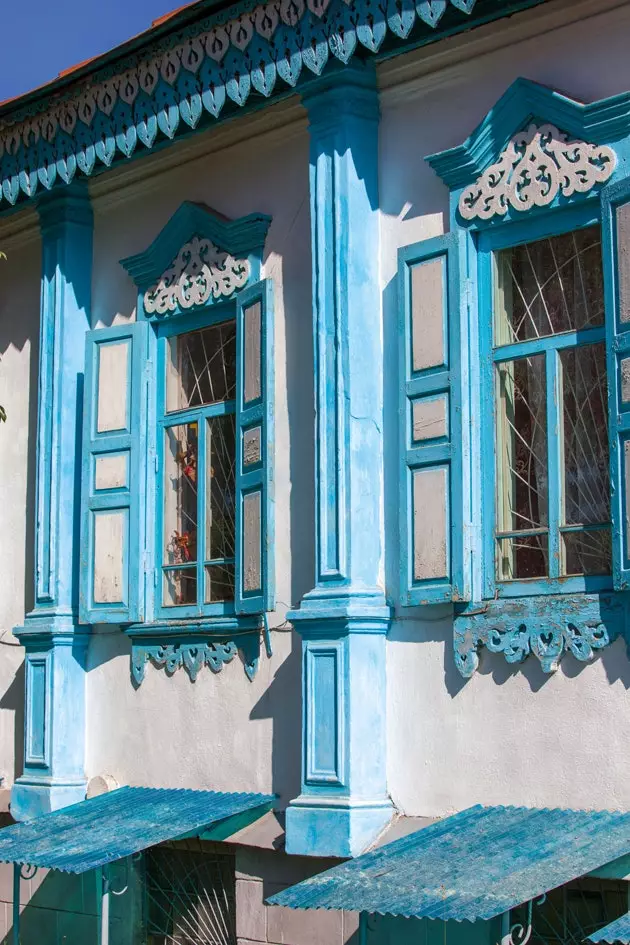
Detail of a house in Karakol
Upon returning, our strength is so low that we stop to rest in a group of yurts where some shepherds live. The men see us so agitated that they lend us a horse to carry our backpacks and send a boy to guide us to our camp and then return with the mule. The hospitality of the steppes! Along with the landscapes, the contact with this town that has lived for centuries with their horses, their herds and their collapsible yurts in these highlands is, without a doubt, the best of a trip through Kyrgyzstan.
My journey ends in karakol , a city of about 75,000 inhabitants at the eastern end of the lake Issyk-Kul . Not that it's a big city, but after days of yurts and humble B&Bs and eating with Kyrgyz families, it is a good opportunity to reconnect with modern life and go to an urban center (it can be called that) to eat in a restaurant without using your hands as a spoon and fork. Or let your stomach recover the nearby flavors in a pizzeria.
I enter a cemetery, a custom I have wherever I travel: the dead always provide a lot of information about the living in the place. And I check that in Kyrgyzstan There is a lot of death worship. In addition to the name, the tombstone is engraved almost the entire curriculum of the deceased: what he worked for, his position in society, his wealth, etc. The tombs are not facing Mecca , although the Kyrgyz are Muslims, but to the driveway of the cemetery. Some have crescents, but many still bear the red Soviet star. “They are from World War II combatants, decorated for some reason during the time of Soviet rule,” my driver clarifies with an illustrative spirit.
Karakol also has some monuments worth visiting. The most famous is dunghuan mosque, a great example of Sino-Muslim architecture from the Qing dynasty era, built in 1910 entirely of wood and without using a single nail. Even more photogenic is the church of the Holy Trinity , a 19th-century Russian Orthodox temple topped by five elegant golden domes. Lovers of exploration history will also enjoy the memorial and museum of Nikolaï M. Prjevalski , a Russian explorer and soldier who was the first to enter these regions of Central Asia and reach Tibet.
My last reflection is the following: although I, a citizen of the 21st century, have found this whole world of the Asian steppes to be wild and exotic, I can imagine –and of course envy– the state of continuous surprise in which he was during his traveling feat the nineteenth-century adventurer Nikolai Przewalski for these same scenarios.
* This article is published in the May 84 issue of the Condé Nast Traveler magazine. This number is available in its digital version for iPad in the iTunes AppStore, and in the digital version for PC, Mac, Smartphone, iPad and iPhone in the Zinio virtual kiosk (on Smartphone devices: Android, PC/Mac, Win8, WebOS, Rim, iPad, iPhone). Also, you can find us on Google Play Newsstand (for Android smartphones and tablets) .
* You may also be interested in... - What's in Turkestan?
- Slow cities: calm tourism
- Tourism without a soul: abandoned places
- The eleven least visited places in the world
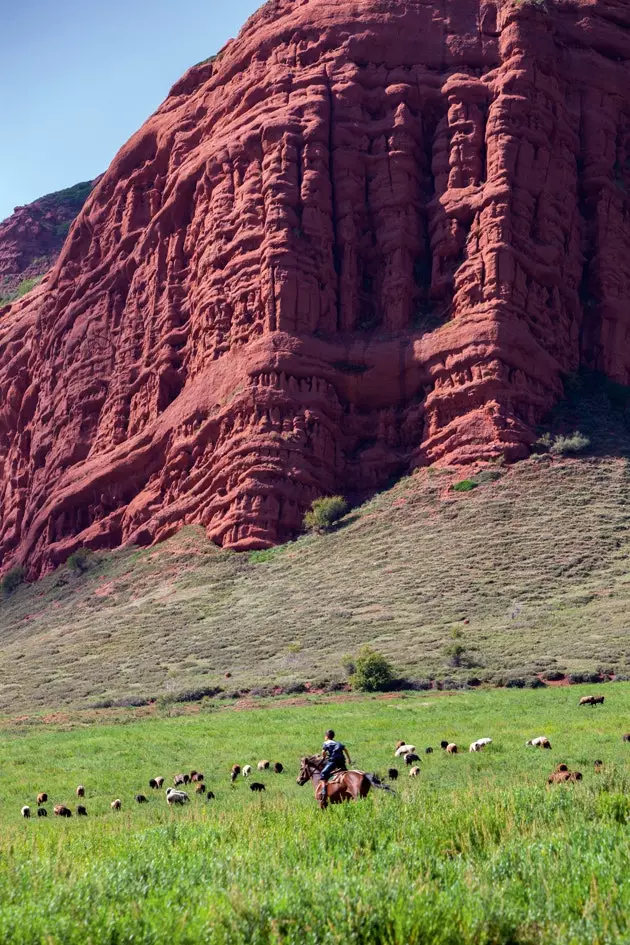
The boys become great riders of the steppe
